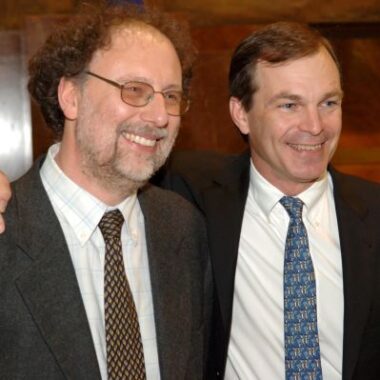Italy - USA
Paolo de Bernardis and Andrew Lange
2006 Balzan Prize for Observational Astronomy and Astrophysics
For their contributions to cosmology, in particular the BOOMERanG Antarctic balloon experiment.
Distant galaxies move away from us at speeds that are proportional to their distance. This indicates that, in the past, the Universe was much smaller and denser than it is today, suggesting the idea of the Big Bang. This theory was confirmed in 1964, when A. Penzias and R. Wilson discovered that the Universe is bathed in a very uniform radiation with an average wavelength of a few millimeters, the so called “Cosmic Microwave Background” (CMB). The most natural explanation for this radiation is that it is a remnant from a very early stage in the history of the Universe.
When we observe far away regions in the Universe, we are also looking far back in time, because it takes time for the light to reach us from distant sources. The CMB originates from the most distant reaches, and thus from the earliest time that we can see. When the Universe was less than 380,000 years old, it was so hot that all atoms were ionized, creating an opaque fog beyond which we cannot see. 380,000 years after the Big Bang, expansion cooled the universe enough to allow the nuclei and electrons to combine to form the first atoms. The fog dissipated, and the radiation began to spread freely through-out the Universe. The radiation hence carries a detailed image of the Primordial Universe. Due to the expansion of the Universe, the wavelength of the radiation has been stretched, and the radiation is diluted: from the dazzling light that was once visible, today there is a weak background of microwaves. It is extremely uniform: in the entire celestial vault, its intensity varies less than 1 part in 10,000. Still, it is those slight situations that are the origin of structures that would then become clusters of galaxies, galaxies, stars, and planets. One of the most spectacular scientific breakthroughs in the past few decades has been to use the measurement of these microwave fluctuations to precisely test our understanding of the evolution, geometry and composition of the Universe.
The microwave telescope BOOMERanG developed by the teams of Lange and de Bernardis was launched on 29 December 1998 from McMurdo Station in Antarctica and carried by a stratospheric balloon to an altitude of 38 km, where the low atmospheric pressure and low moisture content of the atmosphere facilitate such measurements. The experiment collected data for 11 days without interruption, capturing the first resolved images of the faint structures in the CMB. The team upgraded the instrument and flew it again in 2003, this time detecting yet fainter patterns in the polarization of the CMB.
BOOMERanG has undoubtedly resolved one of the most critical and longstanding problems of cosmology – that of the geometry of space – by demonstrating that the curvature of space is very low and the geometry is close to Euclidean. In this and every other detail the data support the theory of “inflation”, according to which the entire observable universe exploded from a volume of subatomic dimensions a few instants after the Big Bang, in a brief and violent superluminal expansion. From BOOMERanG data, we can conclude that the Universe is about 13,500 million years old, and that only 4% of the mass-energy present is in the form of ordinary matter. The remainder is unknown kinds of matter and forms of “dark” energy, the nature of which we know very little.
Official texts of the General Prize Committee, International Balzan Foundation – “Prize”
